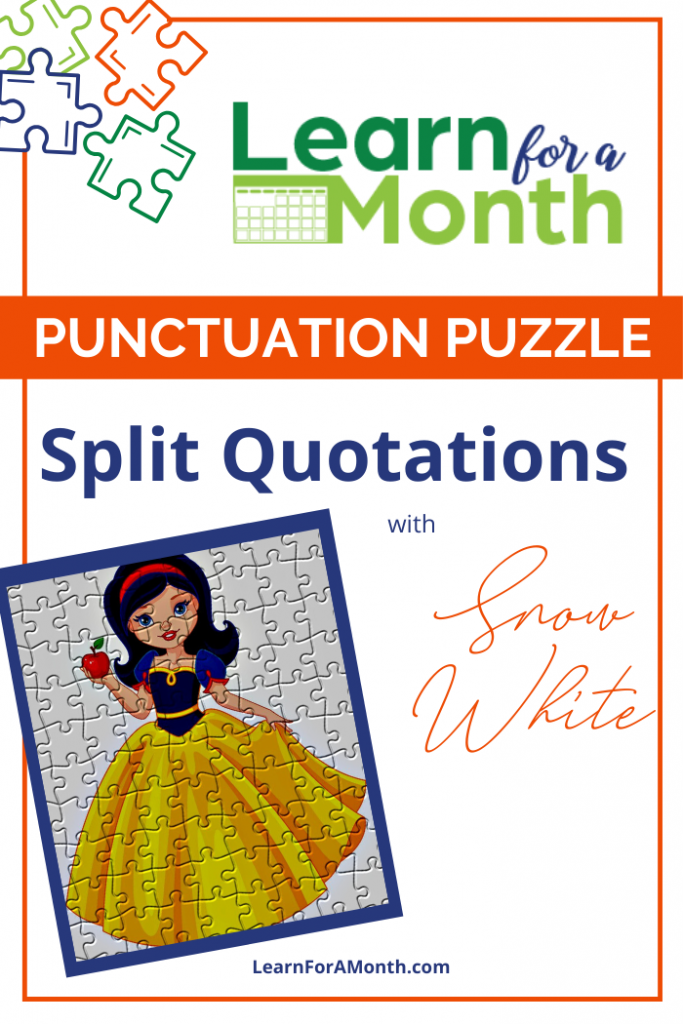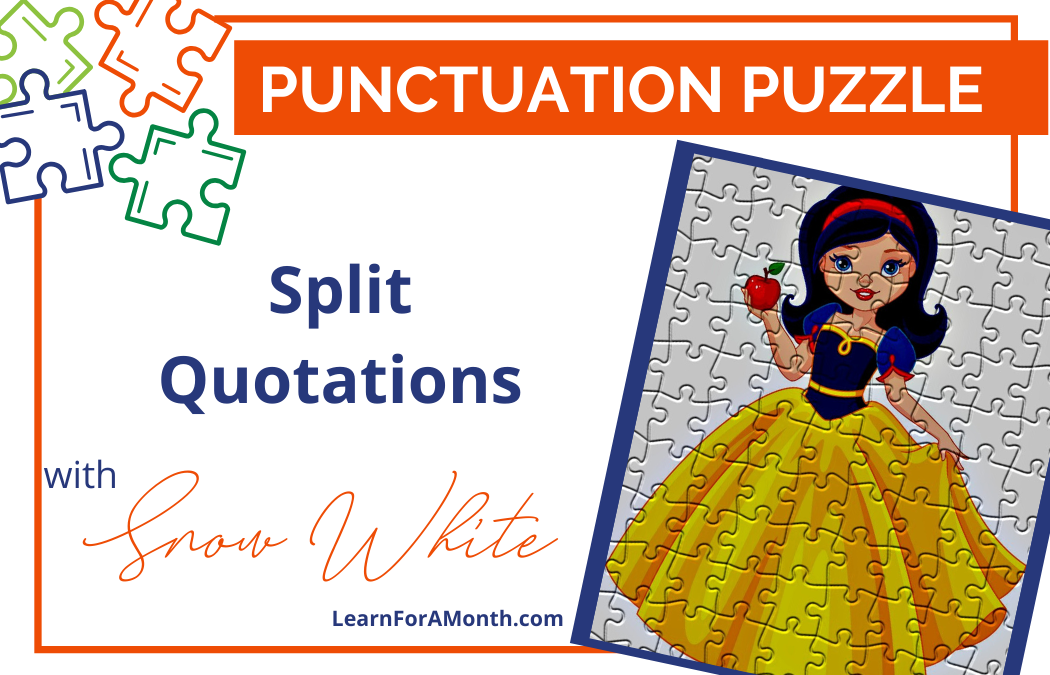If you want to show off in your writing, use a quotation properly. If you want to REALLY show off in your writing, use a split quote properly. Okay, maybe only one to three percent of the people reading your writing will know that your split quote has been written correctly, but YOU will know (and I will know if I see it!), so that counts for something, right? In my books, I teach quotes in an incremental fashion. (This is super important. I just saw a copy work assignment for third graders that contained a split quote {done incorrectly, but still}! Copy work for a third grader should contain very few quotes—and preferably only simple quotes with beginning speech tags at first!)
So what does incremental quotation teaching look like? Here are some suggestions (though don’t let these ideas keep you from working through this week’s puzzle! ? ):
- Simple sentence quotation with BEGINNING speech tag: She said, “Let me take a bite of the apple.”
i. Beginning speech tag quotes do not bring the question of comma or period inside the closing quote.
ii. That makes this the simplest form to start with.
2. Simple sentence quotation with ENDING speech tag: “Let me take a bite of the apple,” she said.
i. This gets way more complicated! You have to deal with the comma inside the closing quotation mark AND the lower case letter for the ending speech tag.
ii. Be sure to keep all sentences as SIMPLE sentences (subject-verb-object—avoid sentence openers AND compounds in beginning quotation teaching).
3. Advanced sentence quotation with either beginning speech tag or ending speech tag: She said, “Let me take a bite of the apple, for I know I will like it.”
i. Do this only after the ones above are mastered.
ii. Don’t expect students to punctuate quotations with advanced sentence structures correctly if they are unable to punctuate the advanced sentence structures correctly when not in a quote.
4. Single quotes within double quotes
i. Teach this important rule from elementary on: Single quotes are ONLY used within quotes—never by themselves. (People often think single quotes are for “shorter” info—no true! They are only for use inside double quotes.)
ii. This level of quote writing takes a LONG time to teach with lots of practice.
5. Split quotes
i. Very hard (see below!). Should be used only when the other skills are cemented.
ii. Start with this mantra: A quote only qualifies to be used as a split quote if you can cover the speech tag—and the remaining words are one sentence only. (This assumes a thorough understanding of what a real, complete sentence contains.)
For more quotation teaching help (besides Zac’s amazing puzzle below!), check out a recent blog post and video here )
(And check out the Tricky Trick sheet that goes with quotation teaching here)

PUNCTUATION PUZZLE:
“If you believe it is poisoned,” the elderly lady replied. “Let me take a bite to assure you it is not.”
The answer?
“If you believe it is poisoned,” the elderly lady replied, “let me take a bite to assure you it is not.”
Split Quotations
1. The errors in this puzzle all have to do with a concept called split quotations. A split quotation is a quotation that has a speech tag in the middle. This contrasts with a speech tag at the beginning or end of a quotation. Check out the following examples:
The friendly lady pleaded, “Allow me to give you this apple.” (speech tag at the beginning)
“Allow me to give you this apple,” the friendly lady pleaded. (speech tag at the end)
“Allow me,” the friendly lady pleaded, “to give you this apple.” (speech tag in the middle)
2. Split quotations can be tricky to punctuate. There are two rules we have to follow.
a. First, we have to use two commas.
b. The first comma comes after the first part of the quote, but inside the quotation marks.
“Allow me,” the friendly lady pleaded, “to give you this apple.”
c. The second comma comes after the speech tag, but before the rest of the quotation.
“Allow me,” the friendly lady pleaded, “to give you this apple.”
3. The second rule you we have to follow is not capitalizing the first letter of the second half of the quotation.
“Allow me,” the friendly lady pleaded, “to give you this apple.”
We have to do this in order to show that the second part of the quotation is still a part of the previous sentence, not a new, complete sentence by itself.
4. This leads us to an important item: not everything that looks like a split quotation is a split quotation. We have to be careful to not apply the split quotation rules until we know we have a split quotation.
5. The key to identifying a split quotation is identifying whether the quotation is two separate sentences or one complete sentence. If the quotation is one complete sentence it is a split quotation. Let’s look at some examples:
i. “Do not let anyone in,” the dwarves warned. “The queen is devious.”
ii. This quote contains two separate sentences; a.) Do not let anyone in. and b.) the queen is devious.
iii. Therefore, it is not a split quote and should have a period, not a comma after the speech tag. It should also have a capital letter at the beginning of the second part of the quotation, since this section is a complete sentence.
6. Check out this second example:
i. “I promise not to let anyone in,” Snow White answered, “even if they appear friendly.”
ii. This quote contains one complete sentence along with a dependent clause. I promise not to let anyone in is a complete sentence while even if they appear friendly is a dependent clause, not a complete sentence.
iii. Therefore, all the rules of split quotations do apply to this sentence.
Now let’s return to our original problem sentence:
i. “If you believe it is poisoned,” the elderly lady replied. “Let me take a bite to assure you it is not.”
ii. Is this sentence a split quotation or not? (Is it two separate sentences or one complete sentence?)
iii. We can see that our problem sentence is one complete sentence. Let me take a bite to assure you it is not is a complete sentence, but If you believe it is poisoned is a subordinate clause, not a complete sentence.
iv. Therefore, the rules of split quotations apply to this sentence.
v. Adding a comma after the speech tag and capitalizing the first letter (l) in the second part of the quotation, we end up with this:
“If you believe it is poisoned,” the elderly lady replied, “let me take a bite to assure you it is not.”
Today’s Punctuation Puzzle sentence comes from a student writing assignment found in the Snow White Twice-Told Tale, a downloadable Really Writing product that will be available in January 2018. Check out other Really Writing products here.


Trackbacks/Pingbacks